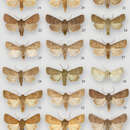Protorthodes mulina: Brief Summary
provided by wikipedia EN
Protorthodes mulina is a moth in the family Noctuidae first described by William Schaus in 1894. It probably has a wide range in Mexico, occurring as far south as the state of Chiapas, but is known from very few localities. In the United States it occurs from western Texas to southeastern Arizona.
The length of the forewings is 13–17 mm. The ground color of the forewings is orange or yellow orange with darker orange-brown lines. Adults are on wing in May and June and again from mid-August to early November, probably in two generations.
- license
- cc-by-sa-3.0
- copyright
- Wikipedia authors and editors
Description
provided by Zookeys
Protorthodes mulina is easily recognized by the orange or yellow-orange ground color of the forewing with the maculation defined by darker orange-brown lines, and especially by the enlarged lower lobe of the reniform spot that is filled with a dark blue gray. Forewing length varying from 13 to 17 mm. The male and female genitalia are divergent from other species in the genus, although several features suggest a relationship to the Protorthodes incincta group; the vesica has a basal cornutus, the subbasal diverticula in the vesica are similar to those of species in the Protorthodes incincta group, but in Protorthodes mulina these structures are much larger than those of other species in the Protorthodes incincta group and the vesica is about twice as long. Unique features of the male genitalia are the enlarged, rounded cucullus, wider than the valve, unlike other species of Protorthodes, the clasper is almost straight with an abrupt 90°bend near the apex, and the digitus is reduced, lying entirely along the inner surface of the valve with the apex slightly expanded and forked. The female genitalia, like other species in the Protorthodes incincta group, has an amorphous sclerotized mass on the posterior part of the ductus bursae; the position and shape of the lobes of the corpus bursae are unique.
- license
- cc-by-3.0
- copyright
- J. Donald Lafontaine, J. Bruce Walsh, Clifford D. Ferris
- bibliographic citation
- Lafontaine J, Walsh J, Ferris C (2014) A revision of the genus Protorthodes McDunnough with descriptions of a new genus and four new species (Lepidoptera, Noctuidae, Noctuinae, Eriopygini) ZooKeys 421: 139–179
- author
- J. Donald Lafontaine
- author
- J. Bruce Walsh
- author
- Clifford D. Ferris
Distribution
provided by Zookeys
Taeniocampa mulina: syntypes in USNM, examined. Type locality: Mexico, [Veracruz], Jalapa. Hyssia pseudochroma: holotype ♂, USNM, examined. Type locality: Mexico, [Veracruz], Zacualpan.
- license
- cc-by-3.0
- copyright
- J. Donald Lafontaine, J. Bruce Walsh, Clifford D. Ferris
- bibliographic citation
- Lafontaine J, Walsh J, Ferris C (2014) A revision of the genus Protorthodes McDunnough with descriptions of a new genus and four new species (Lepidoptera, Noctuidae, Noctuinae, Eriopygini) ZooKeys 421: 139–179
- author
- J. Donald Lafontaine
- author
- J. Bruce Walsh
- author
- Clifford D. Ferris

